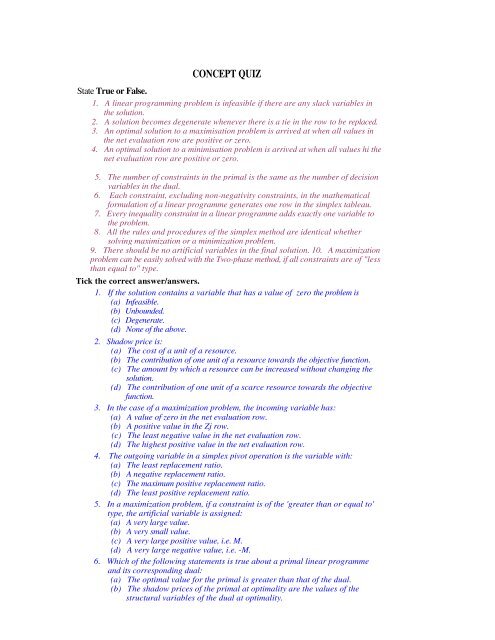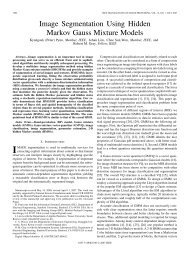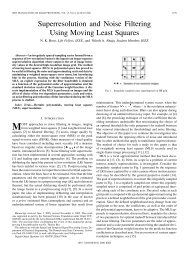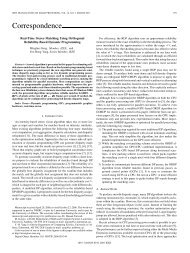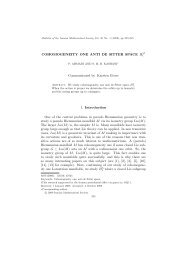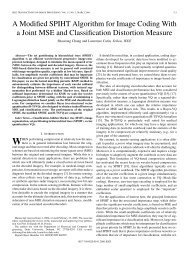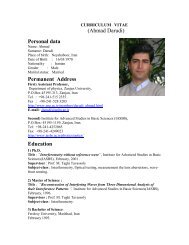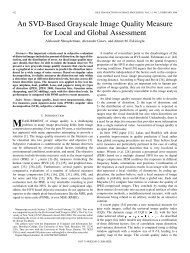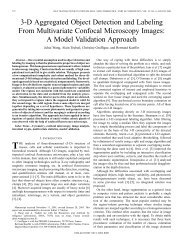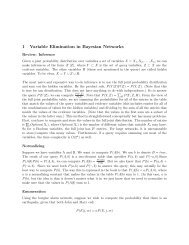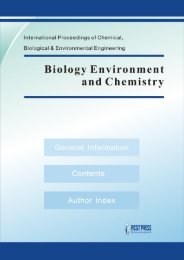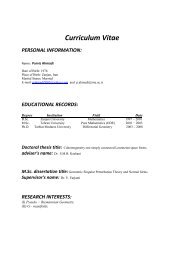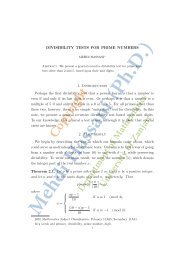You also want an ePaper? Increase the reach of your titles
YUMPU automatically turns print PDFs into web optimized ePapers that Google loves.
CONCEPT QUIZ<br />
State True or False.<br />
1. A linear programming problem is infeasible if there are any slack variables in<br />
the solution.<br />
2. A solution becomes degenerate whenever there is a tie in the row to be replaced.<br />
3. An optimal solution to a maximisation problem is arrived at when all values in<br />
the net evaluation row are positive or zero.<br />
4. An optimal solution to a minimisation problem is arrived at when all values hi the<br />
net evaluation row are positive or zero.<br />
5. The number of constraints in the primal is the same as the number of decision<br />
variables in the dual.<br />
6. Each constraint, excluding non-negativity constraints, in the mathematical<br />
formulation of a linear programme generates one row in the simplex tableau.<br />
7. Every inequality constraint in a linear programme adds exactly one variable to<br />
the problem.<br />
8. All the rules and procedures of the simplex method are identical whether<br />
solving maximization or a minimization problem.<br />
9. There should be no artificial variables in the final solution. 10. A maximization<br />
problem can be easily solved with the Two-phase method, if all constraints are of "less<br />
than equal to" type.<br />
Tick the correct answer/answers.<br />
1. If the solution contains a variable that has a value of zero the problem is<br />
(a) Infeasible.<br />
(b) Unbounded.<br />
(c) Degenerate.<br />
(d) None of the above.<br />
2. Shadow price is:<br />
(a) The cost of a unit of a resource.<br />
(b) The contribution of one unit of a resource towards the objective function.<br />
(c) The amount by which a resource can be increased without changing the<br />
solution.<br />
(d) The contribution of one unit of a scarce resource towards the objective<br />
function.<br />
3. In the case of a maximization problem, the incoming variable has:<br />
(a) A value of zero in the net evaluation row.<br />
(b) A positive value in the Zj row.<br />
(c) The least negative value in the net evaluation row.<br />
(d) The highest positive value in the net evaluation row.<br />
4. The outgoing variable in a simplex pivot operation is the variable with:<br />
(a) The least replacement ratio.<br />
(b) A negative replacement ratio.<br />
(c) The maximum positive replacement ratio.<br />
(d) The least positive replacement ratio.<br />
5. In a maximization problem, if a constraint is of the 'greater than or equal to'<br />
type, the artificial variable is assigned:<br />
(a) A very large value.<br />
(b) A very small value.<br />
(c) A very large positive value, i.e. M.<br />
(d) A very large negative value, i.e. -M.<br />
6. Which of the following statements is true about a primal linear programme<br />
and its corresponding dual:<br />
(a) The optimal value for the primal is greater than that of the dual.<br />
(b) The shadow prices of the primal at optimality are the values of the<br />
structural variables of the dual at optimality.
(c) Each problem does not have a dual.<br />
(d) Both the primal and the dual are either maximisation or minimisation<br />
problems.<br />
7. Right-hand side ranging is used to determine:<br />
(a) The availability of resources.<br />
(b) The requirement of resources.<br />
(c) The range of the resource availability over which the solution remains the<br />
same.<br />
(d) The range of the resource availability over which the shadow prices<br />
remain constant. Right-hand side ranging can<br />
8. be determined by:<br />
(a) Dividing the Cj - Zj row with the Zj row.<br />
(b) Dividing the quantity column by the column representing the slack of the<br />
variable whose range we are determining.<br />
(c) Dividing the quantity column with the column of the incoming variable.<br />
(d) None of the above.<br />
9. In the simplex procedure:<br />
(a) Each successive tableau presents a solution superior to the one preceding it.<br />
The number of tableaus is determined by the number of constraints.<br />
(b) The number of tableaus is determined by the number of variables. None of<br />
(c) the above.<br />
(d) 10.<br />
Artificial variables are required:<br />
(a) Only in a minimisation problem.<br />
(b) Only in a maximisation problem.<br />
(c) To convert inequalities of the 'greater than or equal to' type into equalities.<br />
(d) To convert inequalities of the 'less than or equal to' type into equalities.<br />
1.<br />
2.<br />
3.<br />
4.<br />
5.<br />
6.<br />
7.<br />
QUESTIONS<br />
Explain various steps of the simplex method involved in the computation<br />
of an optimal solution to a linear programming problem.<br />
Define slack and surplus variables in a linear programming<br />
problem. Explain the primal dual relationship.<br />
Explain the meaning of basic feasible solution and degenerate solution<br />
in a linear programming problem.<br />
Explain the use of artificial variable in linear programming.<br />
What do you understand by shadow prices? What is the managerial<br />
implication of shadow prices?<br />
Health Centre is a clinic specializing in four types of patient care: dermatology<br />
cosmetic surgery, obstetrics and neurosurgery. A patient in each of these<br />
specialties contributes Rs 4000, 6000, 8000 and 10000, respectively to profits<br />
of the clinic. Past data reveals the following time requirements limitations:<br />
Hours required per patient<br />
Speciality Lab XRay Therapy Surgery Doctonl<br />
Dermatology 5 8 10 8 14 j<br />
Cosmetics 5 2 1 4 10<br />
Obstetrics 3 1 0 6 8<br />
Neurosurgery 2 4 8 16 12<br />
Hours available per week 200 140 110 240 320<br />
The doctors have access to as many patients as they wish. They have limited their<br />
cosmetic and neurosurgery practice to a total of 150 hours a week. Determine the
optimal patient mix on a weekly basis.<br />
8. The Annual Handmade Furniture Show and Sale occurs next month and the<br />
School for Vocational Training is planning to make furniture for the sale. There are<br />
three wood working classes—I year, II year and III year, at the school and they<br />
have decided to make three styles of chairs—A, B and C. Each chair must receive<br />
work in each class and the time in hours required for each chair in each class is<br />
given below:<br />
Chair<br />
I Year<br />
// Year<br />
/// Year<br />
A<br />
B<br />
2<br />
3<br />
2<br />
4<br />
3<br />
1<br />
3<br />
2<br />
4
9.<br />
During the next month there will be 120 hours in the I Year class, 160 hours in<br />
the II Year class and 100 hours in the III Year class. The teacher of the wood<br />
working classes feels that a maximum of 40 chairs can be sold at the show. The<br />
teacher has determined that the profit from each type of chair will be: A, Rs 400;<br />
B, Rs 350 and C, Rs 300. Determine the optimal mix of chairs using the simplex<br />
method.<br />
A furniture company can produce 4 types of chairs. Each chair is first made in the<br />
carpentry shop and then varnished, waxed and polished in the finishing shop.<br />
Man hours required in each shop are:<br />
10.<br />
11.<br />
Chair type<br />
Shop 7 2 3 4<br />
Carpentry 4 9 7 10<br />
Finishing 1 1 3 40<br />
Contribution 120 200 180 400<br />
Total number of man hours available per month in Carpentry and Finishing<br />
shops are 6000 and 4000, respectively. Assuming abundant supply of raw<br />
materials and unlimited demand for finished products, determine the number of<br />
each type of chair to be produced for profit maximisation, using the simplex<br />
method.<br />
A factory engaged in the manufacture of pistons, rings and valves, for which<br />
the profits per unit are Rs 10, 6 and 4 respectively, wants to decide the most<br />
profitable mix. It takes 1 hour of preparatory work, 10 hours of machining and 2<br />
hours of packing and allied formalities for a piston. Corresponding<br />
requirements for rings and valves are 1, 4 and 2 and 1, 5 and 6 hours,<br />
respectively. The total number of hours available for preparatory work, packing<br />
and allied formalities is 100, 600 and 300, respectively. Determine the most<br />
profitable mix, assuming that whatever is produced can be sold.<br />
Three products A, B and C are produced at three machining centres X, Y and Z<br />
Each product involves operations at each of the machine centres. The time<br />
required for each operation on various products is given in the table below:<br />
Machine centres<br />
Product X Y Z Profit per unit<br />
A 10 7 2 12<br />
B 2 3 4 3<br />
C 1 2 1 1<br />
Available hours 100 77 80<br />
(a) Formulate a linear programming problem on the basis of the above<br />
information.<br />
(b) Find a suitable product mix so as to maximise profit.<br />
(c) Show that the total available hours of X and Y have been fully utilized<br />
and there is surplus hours of Z.
12. A company manufactures three models of cars. There is a backlog of orders<br />
with the company. Model A requires 60, 100 and 80 worker-days in three<br />
production processes. Model B requires 100, 240 and 100 worker-days. Model C<br />
requires 200, 360 and 160 worker-days, respectively in the three production<br />
processes. The number of workers employed in the three production processes is 15,<br />
30 and 15 respectively, and an average worker is on the job for 200 working days a<br />
year. The expected profit for each model is Rs 7500, Rs 15000 and Rs 30000<br />
respectively. With this capacity determine the company's optimal product-mix<br />
and total maximum profit. If there is any other optimal product mix, identify<br />
that too.<br />
13. A manufacturer has to decide how much finishing to perform on his product<br />
prior to sale. He may sell his product as:<br />
(a) Raw castings—5 hours for casting, 1 hour for machining and 1 hour for<br />
plating.<br />
(b) Semi finished—5 hours of casting, 4 hours of machining and 2 hours of<br />
plating.<br />
(c) Finished—5 hours of casting, 4 hours of machining, and 4 hours of plating.<br />
The profit per unit of sale is: Raw casting—Rs 150 per unit; semi finished— Rs<br />
250 per unit and finished—Rs 350 per unit. The manufacturer can sell all the<br />
items that he can produce. The weekly production capacity of the casting<br />
department is 130 hours. The machining department has a capacity of 88 hours<br />
and the plating department has a capacity of 40 hours per week. What should<br />
the product mix be to maximise profits?<br />
14. A trucking company with Rs 4000000 to spend on new equipment is<br />
contemplating three types of vehicles. Vehicle A has a 10 ton payload and is<br />
expected to average 35 km per hour. It costs Rs 80000. Vehicle B has a 20 ton<br />
payload and is expected to average 30 km per hour. It costs Rs 130000. Vehicle C<br />
is a modified form of Vehicle B; it carries sleeping quarters for one driver and that<br />
reduces its carrying capacity to 18 tons and raises the cost to Rs 150000.<br />
Vehicle A requires a crew of one man, and if driven on three shifts per day,<br />
could be run for an average of 18 hours per day. Vehicles B and C require a<br />
crew of two men each, but whereas B would be driven 18 hours per day with<br />
three shifts, C would average 21 hours per day. The company has 150 drivers<br />
available each day and would find it difficult to obtain further crews.<br />
Maintenance facilities are such that the total number of vehicles must not<br />
exceed 30. How many vehicles of each type should be purchased if the company<br />
wishes to maximise its capacity in ton-km per day?<br />
15. A firm makes two products X and Y and has total production capacity of 9 tons<br />
per day, X and Y requiring the same production capacity. The firm has a<br />
permanent contract to supply at least 2 tons of X and at least 3 tons of Y per day<br />
to another company. Each ton of X requires 20 machine hours of production<br />
time and each ton of Y requires 50 machine hours of production time; the daily<br />
maximum possible number of machine hours is 360. All the firms output can be<br />
sold, and the profit made is Rs 80 per ton of X and Rs 120
16.<br />
17.<br />
18.<br />
19.<br />
per ton of Y. It is required to determine the production schedule for maximum<br />
profit and to calculate this profit.<br />
The ABC Candy Company makes three different types of candy bars. The<br />
ingredients, in grams, for each candy bar are as follows:<br />
Candy bar Per unit Chocolate Nuts Caramel Weekly<br />
contribution<br />
A Rs. 2.00 12 4 15 900<br />
demand<br />
B Rs. 2.50 6 10 8 Very large<br />
C Rs. 1.50 10 2 15 Very large<br />
Availability 25000 15000 30000<br />
What should be the product mix to maximise the profits?<br />
The ABC Company sells two types of porch furniture, gliders and chairs. It<br />
makes a profit of Rs 100 on each glider and Rs 40 on each chair. Each glider<br />
requires 40 square feet of display space and each chair requires 25 square feet of<br />
display space. It takes 1% hours to assemble a glider and 2/3 hours to assemble<br />
a chair. ABC has 900 square feet space and 30 hours of labour available for<br />
assembly. The sales manager wants at least two chairs displayed for every glider<br />
displayed. Formulate and solve the LP model.<br />
Mr. Jain, the marketing manager of ABC Typewriter Company, is trying to<br />
decide how to allocate his salesmen to the company's three primary markets.<br />
Market 1 is in an urban area and salesmen can sell on the average 40<br />
typewriters per week. Salesmen in the other two markets can sell on the<br />
average, 36 and 25 typewriters per week, respectively. For the coming week<br />
three of the salesmen will be on leave, leaving only 12 men for duty. Also<br />
because of lack of company cars, maximum of 5 salesmen can be allocated to<br />
Market 1. The selling expenses for salesmen per week for salesmen in each area<br />
are Rs 800 for Market 1 and Rs 700 and Rs 500 per week for Markets 2 and 3,<br />
respectively. The budget for the next week is Rs 7000. The profit margin per<br />
typewriter is Rs 150. Determine how many salesmen should be assigned to each<br />
area so as to maximise the profits.<br />
A certain manufacturer of screw fastenings found that there was a market for<br />
packages of mixed screw sizes. His market research data indicated that two<br />
mixtures of three screw types (1, 2 and 3) properly priced would be most<br />
acceptable to the buyer. The relevant data is:<br />
Mixture Specifications Selling price<br />
A<br />
B<br />
> 50% Type 1<br />
< 30% Type 2<br />
any quantity of Type 3<br />
> 35% of Type 1<br />
< 45% of Type 2<br />
any quantity of Type 3<br />
Rs 5 per kg<br />
Rs 4 per kg
For these screws, plant capacity and manufacturing costs are given below:<br />
Screw type<br />
Plant capacity (kg /day<br />
x 100)<br />
1 10 4.50<br />
2 10 3.50<br />
3 6 2.70<br />
Manufacturing cost<br />
(Rs/kg)<br />
What production should the manufacturer schedule for greatest profits<br />
assuming that he can sell all that he manufactures?<br />
20. A piano manufacturer manufactures three types of pianos. The data below give the<br />
production hours per unit in each of the three operations, maximum time<br />
available and profit per unit.<br />
Operations (hrs)<br />
Profit per unit<br />
Piano types 1 2 3 (OOs of Rs)<br />
A 2 5 5 30<br />
B 4 2 2 40<br />
C 2 3 10 20<br />
Max time available 600 400 900<br />
How many units of each type of piano should be produced to maximise the total<br />
profit? Write the dual and use it to check the optimal solution.<br />
21. Four products have to be processed through the plant. There are three<br />
production lines on which the products could be processed. The rates of<br />
production in units per day, the total available capacity and the demand are<br />
given in the following table:<br />
Product<br />
IVj<br />
Production line 1 2 3 tax. line capacity<br />
4<br />
(days)<br />
A 150 100 500 400 20<br />
B 200 100 760 400 20<br />
C 160 80 890 600 18<br />
Demand 2000 3000 3000 6000<br />
Formulate the above as a linear programming problem to minimise the cost of<br />
operations, if Line A requires Rs 3000 per day, Line B Rs 5000 per day and Line<br />
C Rs 4000 per day. Solve using suitable software package.<br />
22. Formulate and solve the dual of Question 21.
23. Product A offers a profit of Rs 25 per unit and product B yields a profit of Rs 40<br />
per unit. To manufacture the products, leather, wood and glue are required in the<br />
amount as shown below:<br />
Resources required for one unit<br />
Product Leather (kg) Wood (sq m) Glue (litres)<br />
A 0.50 4 0.2<br />
B 0.25 7 0.2<br />
Availability 2200 28000 1400<br />
24.<br />
25.<br />
(a) Formulate the LP model and find the optimal solution.<br />
(b) Which resources are fully consumed? How much of each resource remains<br />
unused?<br />
(c) What are the shadow prices of the resources?<br />
A company manufactures two different kinds of machines, each requiring a<br />
different manufacturing technique. The Deluxe machine requires 18 hours of<br />
labour, 9 hours of testing, and yields a profit of Rs. 400. The Standard machine<br />
requires 3 hours of labour, 4 hours of testing, and yields a profit of Rs. 200.<br />
There are 800 hours of labour and 600 hours of testing available each month. A<br />
marketing forecast has shown that the monthly demand for the Standard<br />
machine to be no more than 250. Management wants to know the number of<br />
each model to produce monthly that will maximise total profits. Formulate and<br />
solve this as a linear programming problem.<br />
A metal product company produces waste cans, filing cabinets, file boxes for<br />
correspondence and lunch boxes. Its inputs are sheet metals of two different<br />
thicknesses, called A and B and manual labour. Input output relationships for<br />
the company are shown in the table.<br />
Waste cans<br />
Filing cabinets Correspondence boxes Lunch<br />
boxes<br />
26.<br />
Sheet metal A 6 0 2 3<br />
Sheet metal B 0 10 0 0<br />
Labour 4 8 2 3<br />
The sales revenue per unit of waste cans, filing cabinets, correspondence boxes<br />
and lunch boxes are Rs 20, Rs 400, Rs 90 and Rs 20, respectively. There are 225<br />
units of Sheet metal A available in the company's inventory, 300 of Sheet metal<br />
B, and 190 units of labour. What is the company's optimal sales revenue?<br />
A knitting machine can produce 1000 trousers or 3000 shirts (or a combination of<br />
the two) each day. The finishing department can handle either 1500 trousers or<br />
2000 shirts (or a combination of the two) each day. The marketing department<br />
requires that at least 400 trousers be produced each day. The company's<br />
objective is profit maximisation. If the profit from the trousers is Rs 40 and that<br />
from a shirt is Rs 15, how many of each type should be produced?
118 Quantitative Techniques for Decision Making<br />
27.<br />
A manufacturing company makes three products, each of which requires three<br />
operations as part of the manufacturing process. The company can sell all of the<br />
products it can manufacture but its production capacity is limited by the capacity<br />
of its operations centres. Additional data concerning the company is as follows:<br />
Manufacturing requirements hour/unit<br />
Product Centre 1 Centre 2 Centre 3<br />
Cost<br />
(Rs)<br />
Selling price<br />
(Rs)<br />
A 1 3 2 11 15<br />
B 3 4 1 12 20<br />
C 2 2 2 10 16<br />
Hours available 160 120 80 -<br />
What should the product mix be? Write the dual of the given problem.<br />
28.<br />
29.<br />
Three products A, B and C are to be manufactured. Product A requires<br />
2.4 minutes of punch press time and 5.0 minutes of assembly time. Product B<br />
requires 3.0 minutes of punch press time and 2.5 minutes of welding time.<br />
Product C requires 2.0 minutes of punch press time and 1.5 minutes of welding<br />
time and 2.5 minutes of assembly time. Profit per unit of A, B and C is Re 0.60,<br />
Re 0.70 and Re 0.50, respectively. The capacity of the punch press is 20 hours<br />
per week, of welding 10 hours per week and of assembly section<br />
25 hours per week. Find the optimal feasible solution and the maximum profit.<br />
Also determine the shadow prices of the three resources.<br />
A chemical manufacturing company produces two products A and B. Each<br />
product passes through three processes. The processing time in hours for each of<br />
the two products in each process is given below:<br />
Process Product A Product B<br />
1 2 5<br />
2 7 2<br />
3 4 3<br />
The total hours available for each process in a week are 30, 24 and 20,<br />
respectively. Product A gives a profit of Rs 18 per unit and one unit of Product<br />
B gives Rs 15. Find the quantities of A and B to be produced in the next week so<br />
as to maximise profits.
A timber merchant manufactures three types of plywood. The data given in the<br />
following table shows the production hours per unit in each of three production<br />
operations, maximum time available and profits per unit.<br />
Operations (hrs)<br />
Plywood / II III Profit per unit (Rs)<br />
Grade A 2 2 4 40<br />
Grade B 5 5 2 30<br />
Grade C 10 3 2 20<br />
Max time available 900 400 600<br />
How many units of each grade of plywood should be produced to maximise the<br />
total profit?<br />
31. A local travel agent is planning a charter trip to a major sea resort. The eight day<br />
seven night package includes the fare for the round trip travel, surface<br />
transportation, board and lodging and selected tour options. The charter trip is<br />
restricted to 200 persons and past experience indicates that there will be no<br />
problem in getting 200 persons. The problem for the travel agent is to determine<br />
the number of Deluxe, Standard and Economy tour packages to offer for this<br />
charter. These three plans each differ according to seating and service on the<br />
flight, quality of accommodation, meal plans and tour options. The following<br />
table summarises the estimated price for the three packages and the<br />
corresponding expenses for the travel agent per person. The travel agent has<br />
hired an aircraft for a flat fee of Rs 200000 for the entire trip.<br />
Tour plan Price (Rs) Hotel costs (Rs) Meals and other expenses (Rs)<br />
Deluxe 10000 3000 4750<br />
Standard 7000 2200 2500<br />
Economy 6500 1900 2200<br />
In planning the trip the following considerations must be taken into account:<br />
(a) At least 10 per cent of the packages must be of the deluxe type.<br />
(b) At least 35 per cent but not more than 70 per cent must be of the Standard<br />
type.<br />
(c) At least 30 per cent must be of the Economy type.<br />
(d) The maximum number of Deluxe packages available in any aircraft is<br />
restricted to 60.<br />
(e) The hotel desires that at least 120 tourists should be on the Deluxe and<br />
Standard packages together.<br />
Determine the number of packages to offer in each type so as to maximise profits.
34.<br />
32. XYZ Company Y\as three departments—assembly, painting and packing,<br />
and Can make three types of almirahs. An almirah of Type 1 requires one<br />
hour assembly, 40 minutes of painting and 20 minutes of packing time,<br />
respectively Similarly almirah of Type II 80 minutes, 20 minutes and 1 hour,<br />
respectively. The Type III requires 40 minutes each of assembly, painting and<br />
packing time .The total time available at assembly, painting and packing<br />
departments is 600 hours, 400 hours and 800 hours, respectively. Type I, Type II<br />
and Type III almirahs yield Rs 1000, 1500 and 2000 as profit respectively.<br />
(a) Determine the number of almirahs of each type that should be produced in<br />
order to maximise the profits.<br />
(b) If XYZ Company decides to rent out its capacity to another almirah<br />
manufacturer—ABC Company, what should it charge as rental rates?<br />
A company makes three products X, Y and Z, which flow through three<br />
departments: Drill, Lathe and Assembly. The hours required by each product in<br />
each department, the profit contribution of the products and the total time<br />
available in each department are shown in the table below:<br />
Time required per unit<br />
Product Drill Lathe Assembly Profit per unit<br />
X 3 3 8 9<br />
Y 6 5 10 15<br />
Z 7 4 12 20<br />
Hours available 210 240 260<br />
35.<br />
The marketing department indicates that the sales potential for Products X and Y<br />
is unlimited but for the Product Z it is only 30 units. Determine the optimal j<br />
product mix.<br />
A manufacturer produces four products, A, B, C and D, each of which is<br />
processed on three machines, X, Y and Z. The time required for manufacturing one<br />
unit of each of the four products and capacity of each machine is indicated as<br />
follows:
Product Processing time in hrs Profit per unit<br />
Machine X Machine Y Machine Z<br />
A 1.5 4 2 4<br />
B 2 1 3 6<br />
C 4 2 1 3<br />
D 3 1 2 1<br />
Capacity 550 700 200<br />
(a) What is the optimal product mix? What is the maximum profit?<br />
(b) Which machine (s) has(have) excess capacity? How much?<br />
(c) If the profit contribution from Product B increases by Rs 2 per unit, will the<br />
optimal product mix change?<br />
(d) If machine Y is to be shut down for 50 hours due to repairs, will the product<br />
mix change?<br />
(e) What are the shadow prices of the machine hours on the three machines?<br />
36. ABC Foods Company is developing a low calorie high protein diet supplement<br />
called Hi-Pro. The specifications for Hi-Pro have been established by a panel of<br />
medical experts. These specifications along with the calorie, protein and vitamin<br />
content of the three basic foods are given in the following table:<br />
Nutritional elements<br />
Units of nutritional<br />
(per 100 gm basic<br />
elements<br />
food)<br />
Food 1 Food 2 Food 3 Hi-Pro<br />
Calories 350 250 200 300<br />
Proteins 250 300 150 200<br />
Vitamin A 100 150 75 100<br />
Vitamin B 75 125 150 100<br />
Cost per serving (Rs) 1.50 2.00 1.20<br />
What quantities of Food 1, Food 2 and Food 3 should be used?


